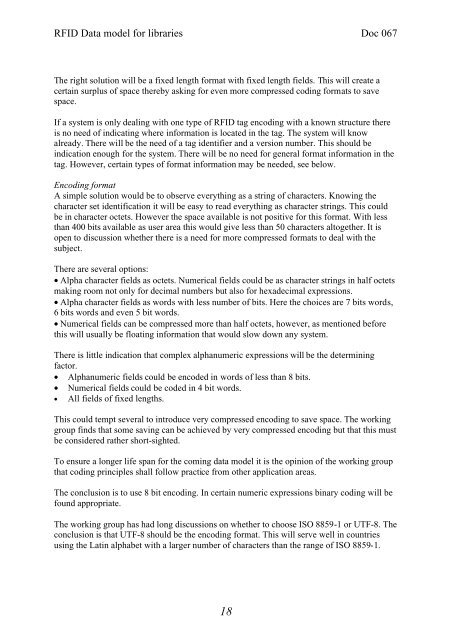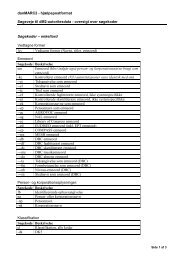RFID Data Model for Libraries - biblstandard
RFID Data Model for Libraries - biblstandard
RFID Data Model for Libraries - biblstandard
Create successful ePaper yourself
Turn your PDF publications into a flip-book with our unique Google optimized e-Paper software.
<strong>RFID</strong> <strong>Data</strong> model <strong>for</strong> libraries Doc 067<br />
The right solution will be a fixed length <strong>for</strong>mat with fixed length fields. This will create a<br />
certain surplus of space thereby asking <strong>for</strong> even more compressed coding <strong>for</strong>mats to save<br />
space.<br />
If a system is only dealing with one type of <strong>RFID</strong> tag encoding with a known structure there<br />
is no need of indicating where in<strong>for</strong>mation is located in the tag. The system will know<br />
already. There will be the need of a tag identifier and a version number. This should be<br />
indication enough <strong>for</strong> the system. There will be no need <strong>for</strong> general <strong>for</strong>mat in<strong>for</strong>mation in the<br />
tag. However, certain types of <strong>for</strong>mat in<strong>for</strong>mation may be needed, see below.<br />
Encoding <strong>for</strong>mat<br />
A simple solution would be to observe everything as a string of characters. Knowing the<br />
character set identification it will be easy to read everything as character strings. This could<br />
be in character octets. However the space available is not positive <strong>for</strong> this <strong>for</strong>mat. With less<br />
than 400 bits available as user area this would give less than 50 characters altogether. It is<br />
open to discussion whether there is a need <strong>for</strong> more compressed <strong>for</strong>mats to deal with the<br />
subject.<br />
There are several options:<br />
• Alpha character fields as octets. Numerical fields could be as character strings in half octets<br />
making room not only <strong>for</strong> decimal numbers but also <strong>for</strong> hexadecimal expressions.<br />
• Alpha character fields as words with less number of bits. Here the choices are 7 bits words,<br />
6 bits words and even 5 bit words.<br />
• Numerical fields can be compressed more than half octets, however, as mentioned be<strong>for</strong>e<br />
this will usually be floating in<strong>for</strong>mation that would slow down any system.<br />
There is little indication that complex alphanumeric expressions will be the determining<br />
factor.<br />
• Alphanumeric fields could be encoded in words of less than 8 bits.<br />
• Numerical fields could be coded in 4 bit words.<br />
• All fields of fixed lengths.<br />
This could tempt several to introduce very compressed encoding to save space. The working<br />
group finds that some saving can be achieved by very compressed encoding but that this must<br />
be considered rather short-sighted.<br />
To ensure a longer life span <strong>for</strong> the coming data model it is the opinion of the working group<br />
that coding principles shall follow practice from other application areas.<br />
The conclusion is to use 8 bit encoding. In certain numeric expressions binary coding will be<br />
found appropriate.<br />
The working group has had long discussions on whether to choose ISO 8859-1 or UTF-8. The<br />
conclusion is that UTF-8 should be the encoding <strong>for</strong>mat. This will serve well in countries<br />
using the Latin alphabet with a larger number of characters than the range of ISO 8859-1.<br />
18




